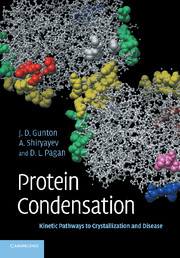In this chapter we provide a brief summary of some of the methods used to study the physical properties of proteins in solution. This is not meant as a thorough discussion of experimental techniques, but rather as an introduction with sufficient references to provide the interested reader with a guide to the literature.
Methods to determine three-dimensional protein structure
As noted earlier, knowing the structure of a protein molecule is crucial to understanding its biological function. Over the past century, efforts have been focused on methods which allow protein structure to be determined. X-ray crystallography and NMR studies are two popular techniques, the former being predominant.
X-ray crystallography
X-ray crystallography [13, 14] of protein crystals is a well known technique, which we briefly summarize here. Its use for protein crystals, of course, depends upon the regular arrangement of protein molecules on a crystal lattice. When electromagnetic radiation of a given wavelength, such as X-rays, is incident upon a grating of appropriately sized spacings, the waves interfere constructively and destructively in a process known as diffraction. The diffraction pattern is a three-dimensional image of the crystal in reciprocal space and can be used ultimately to determine the real structure of the lattice; it represents the scattering of the X-rays by the electrons of the atoms in the crystal.
